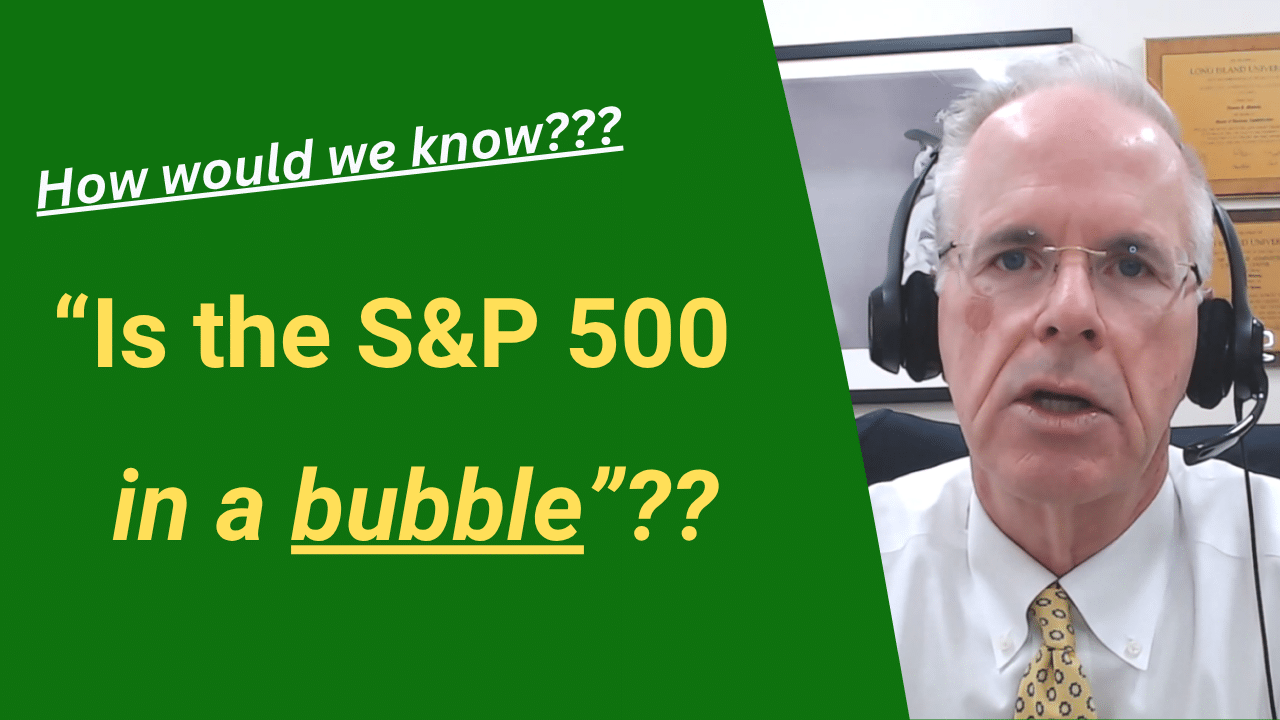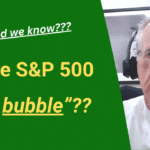Is the S&P 500 in a bubble?
Key Takeaways:
-
The very same top 8 mega-cap tech stocks dominate both NASDAQ 100 and S&P 500
-
Market concentration is high – but not unprecedented, or necessarily a bubble
-
Sector leadership shifts over time: industrials, energy, finance, now tech
-
Enron’s fall and Nvidia’s rise show how quickly market leaders can change
Is the S&P 500 in a bubble? – Links
Catch all our Mullooly Asset videos here
Subscribe to the Mullooly Asset YouTube Channel
Watch this episode (“Is the S&P 500 in a bubble?”) on our YouTube Channel
Jim Bianco (Bianco Research) LinkedIn post on the top 8 names
Is the S&P 500 in a bubble? – Transcript
Is the S&P 500 in a bubble?
Are we in a bubble right now?
We’re recording this in October of 2025.
And what we’re seeing might be a fluky coincidence. We want to share with you the top eight names that make up the NASDAQ 100 Index as stacked by market capitalization.
These are also the same eight names stacked by market capitalization in the S&P 500 Index.
And, as far as we can tell, we haven’t seen this before.
The top eight names are stacked here by market capitalization.
Now, market capitalization is the number of shares that a company has, times their current market price.
And you can see the number one name right now is Nvidia.
Followed by Microsoft.
And then Apple.
Number four is Alphabet, which is the parent company of Google.
Number five is Amazon.
Number six is Meta, which is the parent company for Facebook.
Followed by Broadcom and Tesla.
What we’d like to point out to you, is take a look at the percentages as they’re all added up.
You can see that the in the S&P 500, these top eight names make up 37% of the S&P 500 Index.
That’s large, but not unprecedented.
Take a look at the NASDAQ 100 list. You can see the top eight names make up 69% of the index.
Now, the Nasdaq 100 index is just 100 names.
The S&P 500, is 500 different companies.
It’s not unusual to see 65%, 70% of the NASDAQ 100 being dominated by a top five, top eight, top 10 list.
A lot of this (index) gets concentrated at the top end of the list.
And as I had mentioned, it’s not unusual. We’ve seen other periods in the past where the top five, top eight or the top 10 names in the S&P 500 also make up a large percentage of stocks.
And we want to walk through some examples right now.
But before we get to that, I want to address the question, “are we in a bubble right now?”
I don’t think so.
But I don’t know how this is going to age, over time.
What I can say is that we are certainly in a bull market for talking about bubbles.
Right now, everywhere you turn in the financial media, all they talk about is the potential for a stock market bubble.
We don’t know how this is going to work out.
Really the only time you can identify a bubble is by looking back at history.
So when we talk about history, it’s important to know that the S&P 500, the basket of 500 companies, wasn’t created until 1957.
Prior to 1957, we had the Dow Jones Industrial Average to talk about.
But even before that, before the Dow Jones (Industrial Average) was created in 1896, they had the Dow Jones Transportation Index.
These were created by Charles Dow.
Dow created the Transport Index in 1884.
In fact, it was originally called the “Dow Jones Railroad Average,” because it was 11 railroad companies.
And when the Dow Jones Industrial Average was created in 1896, as you can guess, it was dominated by the rails.
And that continued for about 25 years.
Until we started seeing Automobile companies start to get added to the list.
When you fast forward to the creation of the S&P 500 index in 1957, Industrials, auto companies, chemical companies, manufacturing companies were 40% of the S&P 500.
(That lasted) from its creation in 1957, for a period of about 20 years, into the mid 1970s.
That is when you saw energy companies, oil stocks, really become the dominant sector in the S&P 500.
From the mid-nineties, up through 2008, it was the banks that dominated, the financial companies dominated the S&P 500. They made up a little more than 25% of the S&P 500 in 2007.
We also saw a brief period of time where the dot coms really “ran the tape” for a while.
Until they imploded in March of 2000.
So one area of the economy can influence the index (or the basket) for many, many years. In fact, decades even.
It does NOT immediately mean we’re in a bubble, or that some bubble is going to imminently pop.
I do want to share something also very interesting here; when we’re talking about the S&P 500.
Go back to the year 2000.
The number seven name on the S&P 500, at the time, by market capitalization, was a company called Enron.
We don’t hear too much about Enron these days.
That’s because they went bankrupt in 2001.
That’s right. The seventh largest company in the S&P 500 went from number seven to “gone” in a very, very short period of time.
Kind of unusual to see them fall, as fast as they did.
It kind of reminds me of the Hemingway quote, “How did you go bankrupt? At first, very slowly. Then, all at once.”
But here’s a fun fact. November 29th, 2001, S&P replaced them (Enron), out of the S&P 500.
So Enron was out.
They were replaced by a company called Nvidia, which is now the number one company, by market capitalization, in the S&P 500 today.









